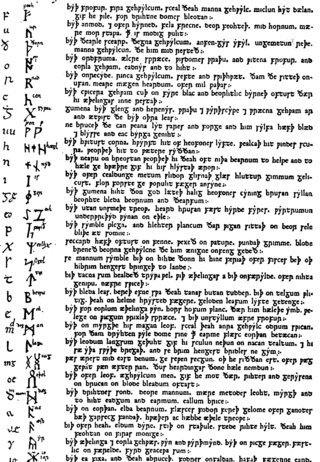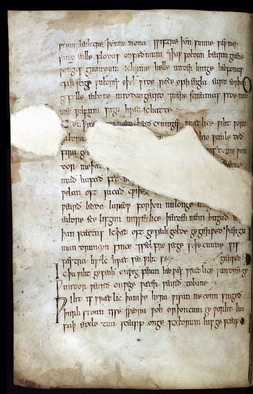
Æsir or ēse are gods in Germanic paganism. In Old Nordic religion and mythology, the precise meaning of the term "Æsir" is debated, with it being able to refer to both the gods in general or specifically to one of the main families of gods, in contrast to the Vanir, with whom they waged war, ultimately leading to a joining of the families. The term can further be used to describe local gods that were believed to live in specific features in the landscape such as fells. In the Old English Wið færstice, the Ēse are referred to, along with elves, as harmful beings that could cause a stabbing pain, although exactly how they were conceived of by the author of the text is unclear.
Othala, also known as ēðel and odal, is a rune that represents the o and œ phonemes in the Elder Futhark and the Anglo-Saxon Futhorc writing systems respectively. Its name is derived from the reconstructed Proto-Germanic *ōþala- "heritage; inheritance, inherited estate". As it does not occur in Younger Futhark, it disappears from the Scandinavian record around the 8th century, however its usage continued in England into the 11th century, where it was sometimes further used in manuscripts as a shorthand for the word ēðel ("homeland"), similar to how other runes were sometimes used at the time.

Wynn or wyn is a letter of the Old English alphabet, where it is used to represent the sound.

A rune is a letter in a set of related alphabets known as runic alphabets native to the Germanic peoples. Runes were used to write Germanic languages before they adopted the Latin alphabet, and for specialised purposes thereafter. In addition to representing a sound value, runes can be used to represent the concepts after which they are named (ideographs). Scholars refer to instances of the latter as Begriffsrunen. The Scandinavian variants are also known as fuþark, or futhark, these names derived from the first six letters of the script, ⟨ᚠ⟩, ⟨ᚢ⟩, ⟨ᚦ⟩, ⟨ᚨ⟩/⟨ᚬ⟩, ⟨ᚱ⟩, and ⟨ᚲ⟩/⟨ᚴ⟩, corresponding to the Latin letters ⟨f⟩, ⟨u⟩, ⟨þ⟩/⟨th⟩, ⟨a⟩, ⟨r⟩, and ⟨k⟩. The Anglo-Saxon variant is futhorc, or fuþorc, due to changes in Old English of the sounds represented by the fourth letter, ⟨ᚨ⟩/⟨ᚩ⟩.
ᛈ is the rune denoting the sound p in the Elder Futhark runic alphabet. It does not appear in the Younger Futhark. It is named peorð in the Anglo-Saxon rune-poem and glossed enigmatically as follows:
The Younger Futhark, also called Scandinavian runes, is a runic alphabet and a reduced form of the Elder Futhark, with only 16 characters, in use from about the 9th century, after a "transitional period" during the 7th and 8th centuries. The reduction, somewhat paradoxically, happened at the same time as phonetic changes that led to a greater number of different phonemes in the spoken language, when Proto-Norse evolved into Old Norse. Also, the writing custom avoided carving the same rune consecutively for the same sound, so the spoken distinction between long and short vowels was lost in writing. Thus, the language included distinct sounds and minimal pairs that were written the same.

The Elder Futhark, also known as the Older Futhark, Old Futhark, or Germanic Futhark, is the oldest form of the runic alphabets. It was a writing system used by Germanic peoples for Northwest Germanic dialects in the Migration Period. Inscriptions are found on artifacts including jewelry, amulets, plateware, tools, and weapons, as well as runestones in Scandinavia, from the 2nd to the 10th centuries.
The Fehu rune ⟨ᚠ⟩ represents the ⟨f⟩ and ⟨v⟩ sound in the Younger Futhark and Futhorc alphabets. Its name means '(mobile) wealth', cognate to English fee with the original meaning of 'sheep' or 'cattle'. The Proto-Germanic name *fehu has been reconstructed, with the meaning of "money, cattle, wealth".
Algiz is the name conventionally given to the "z-rune" ᛉ of the Elder Futhark runic alphabet. Its transliteration is z, understood as a phoneme of the Proto-Germanic language, the terminal *z continuing Proto-Indo-European terminal *s via Verner's law.
Jera is the conventional name of the j-rune ᛃ of the Elder Futhark, from a reconstructed Common Germanic stem *jēra- meaning "harvest, (good) year".

Anglo-Saxon runes or Anglo-Frisian runes are runes that were used by the Anglo-Saxons and Medieval Frisians as an alphabet in their native writing system, recording both Old English and Old Frisian. Today, the characters are known collectively as the futhorc from the sound values of the first six runes. The futhorc was a development from the older co-Germanic 24-character runic alphabet, known today as Elder Futhark, expanding to 28-characters in its older form and up to 34-characters in its younger form. In contemporary Scandinavia, the Older Futhark developed into a shorter 16-character alphabet, today simply called Younger Futhark.
The rune ᚦ is called Thurs in the Icelandic and Norwegian rune poems. In the Anglo-Saxon rune poem it is called thorn, whence the name of the letter þ derived. It is transliterated as þ, and has the sound value of a voiceless dental fricative.
Codex Sangallensis 878 is a manuscript kept in the library of the Abbey of St. Gall, in Switzerland. It dates to the 9th century and probably originates in Fulda monastery. It contains mainly excerpts of grammatical texts, including the Ars minor and Ars major of Aelius Donatus, the grammar of Priscian, the Etymologiae of Isidore of Sevilla and the grammar of Alcuin. Furthermore, it contains a presentation of the Greek alphabet, the Hebrew alphabet, the Anglo-Saxon runes and the Scandinavian Younger Futhark, the latter in the form of a short rune poem known as the Abecedarium Nordmannicum.
Ansuz is the conventional name given to the a-rune of the Elder Futhark, ᚨ. The name is based on Proto-Germanic *ansuz, denoting a deity belonging to the principal pantheon in Germanic paganism.

The Abecedarium Nordmannicum is a presentation of the 16 runes of the Younger Futhark as a short poem, in the 9th-century Codex Sangallensis 878. The Younger Futhark are given after the Hebrew alphabet on the preceding page, and the Anglo-Saxon futhorc on the same page. The text of the rune poem was unfortunately destroyed in the 19th century by chemicals intended for its preservation. It survives in an 1828 drawing by Wilhelm Grimm.
The t-rune ᛏ is named after Týr, and was identified with this god. The reconstructed Proto-Germanic name is *Tîwaz or *Teiwaz. Tiwaz rune was an ideographic symbol for a spear.
Sowilo (*sōwilō), meaning "sun", is the reconstructed Proto-Germanic language name of the s-rune.
*Mannaz is the conventional name of the m-rune ᛗ of the Elder Futhark. It is derived from the reconstructed Common Germanic word for "man", *mannaz.

The Old English rune poem, dated to the 8th or 9th century, has stanzas on 29 Anglo-Saxon runes. It stands alongside younger rune poems from Scandinavia, which record the names of the 16 Younger Futhark runes.

Exeter Book Riddles 68 and 69 are two of the Old English riddles found in the later tenth-century Exeter Book. Their interpretation has occasioned a range of scholarly investigations, but clearly has something to do with ice and one or both of the riddles are likely indeed to have the solution 'ice'.







